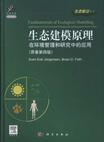生态建模原理
出版时间:2012-1 出版社:科学出版社 作者:约恩森 等编著 页数:399
Tag标签:无
内容概要
《科爱传播·生态前沿系列·生态建模原理:在环境管理和研究中的应用(原著第4版)》为第四版,经过了彻底的修订和更新.权威性地介绍生态建模的概念和发展历程.该领域的最新进展,并为读者介绍了构建自己模型的工具。本书适用于高校和研究单位的研究生教材,也是从事生态学和环境工作的工程技术人员和管理工作者的重要业务参考书。 本书特点: 深入描述最新的建模技术,一步一步勾画建模过程的轮廓,并做了详细讨论。 罗列了不同的模型类型,包括总结表格,实例及插图。 在每一章的结尾附有练习,便于读者学习。 书后附有三个数学附录和主题索引。
作者简介
约恩森(Sven Eric Jorgensen)博士,哥本哈根大学的名誉教授,致力于系统生态学、生态模型和生态工程等方面的研究,已出版专著66部,发表论文350余篇。约恩森博士已担任《国际生态模型和系统生态学杂志》(International Journal on Ecological Modelling and System Ecology)主编34年;他同时还担任《生态学百科全书》(Ency-clopendia of Ecology)的主编。他获得了若干重大奖项(普里戈金奖(ThePrigoineA-ward)、帕斯卡奖(The Pascal Medal),中国科学院爱因斯坦讲席教授等),包括极负盛誉的斯德哥尔摩水科学大奖。约恩森博士是哥伦比亚大学、葡萄牙和坦桑尼亚首都达累斯萨拉姆大学的荣誉博士,欧洲科学院院士,以及国际生态模型学会(ISEM)的主席。 法思(BrianD.Fash)博士是美国马里兰州陶森大学(Towson Univetsity)生物科学系副教授,国际应用系统分析协会(拉克森堡,奥地利)动态系统项目的研究人员,在各类期刊上发表论文、报告和研究著作近100篇。2007年6月,法思博士与约恩森博士共同撰写了其第一部著作《新生态学》(A。NewEcology),2008年,他们又共同编撰了生态学百科全书的5卷内容。自2009年1月起,法思博士开始担任《生态学模型》杂志的主编。他在美国陶森开设了生态系统生态学、环境生物学、网络及人类生态学与可持续发展等课程,还分别在中国、克罗地亚、丹麦、法国、德国和葡萄牙开设了短期课程。法思博士现任巴尔的摩国家环境质量委员会主席。
书籍目录
作者简介
前言
1.绪论
2.模型概念
3.不同模型类型概述
4.协调建模或组合化建模
5.模拟种群动态
6.稳态模型
7.动态生物地化模型
8.生态毒理模型
9.个体模型
10.结构动态模型
11.空间模型
参考文献
附录
章节摘录
a population model by different levels of the populations, and so forth. If an ideal validation cannot be obtained, then it is still important to validate the model as best as possible. The method of validation is dependent on the model objectives. A comparison between measured and computed data using an objective function Eq. (2) is an obvious test. This is, however, often not sufficient, as it may not focus on all the main objectives of the model, but only on the general ability of the model to describe correctly the state variables of the ecosystem. It is necessarv, therefore, to translate the main objectives of the modelinto a few validation criteria. They cannot be formulated generally, but are individual for the model and the modeller. For instance, if we are concerned with the eutrophication in an aquatic ecosystem, it would be useful to compare the measured and computed maximum concen- trations of phytoplankton. The validation discussion can be summarized by the following issues: 1. Validation is always required to get a picture of the model reliability. 2. Attempts should be made to get data for the validation that are entirely different from those used in the calibration. It is important to have data from a wide range of forcing functions that are defined by the model objectives. 3. The validation criteria are formulated based on the model objectives and the quality of the available data. The main purpose of the model may, however, be an exploratory analysis to understand how the system responds to the dominating forcing functions. In this case, a structural validation is probably sufficient. Validation is a very important modelling step because it gives the uncertainty of the model results. It attempts to answer the question: Which model uncertaint)r should we consider when using the model to develop strategies for environmental management? If we use the model as research tool, then the validation will tell us whether the model results can be used to support or reject a hWothesis. The uncer- tainty determined by the validation relative to the difference between the hypothesis and the model results will be decisive. In Chapter 7 ……
媒体关注与评论
这本实用、经过验证的书非常有效地结合了生态建模的理论、方法和应用。生态建模是一个迅迷发展的领域,新版是对这一领域的重要的最新指南……生态建模显然是一个大领域,《生态建模原理:在环境管理和研究中的应用(原著第4版)(导读版)》内容丰富,实用性强,既是一个全面概述,也是一本使用指南。 ——Information Eaux 对于拥有数学背景的生态系统工程师和生态学家而言,这本书将成为宝贵源泉,通过阅读本书,读者可以对生态和环境建模这一迅速发展的领域有一个全面的了解。本书也非常适于作为教科书使用。 ——International Journal of Environmental Analytical Chemistry
编辑推荐
《科爱传播·生态前沿系列·生态建模原理:在环境管理和研究中的应用(原著第4版)》的目录和前言已经译成中文,正文部分保留英文原版。另附华东师范大学陆健健教授所作精彩导读一篇。
图书封面
图书标签Tags
无
评论、评分、阅读与下载
用户评论 (总计1条)
- 版本什么的都不错。可惜的是,包装之前,肯定是野蛮装货,否则书角不会折弯一块,让人心疼。希望当当网管理一下,不要把精装版的书,压折书角,否则下次退货处理。
推荐图书
- 檀林皇后私譜 (下)
- 孔子资料汇编
- 浙江动物志 淡水鱼类
- 臺灣魚類圖鑑
- 台灣鯨類圖鑑
- 魔少年B・T
- ジョジョの奇妙な冒険 1
- ジョジョの奇妙な冒険 2
- ジョジョの奇妙な冒険 3
- ジョジョの奇妙な冒険 4
- ジョジョの奇妙な冒険 5
- ジョジョの奇妙な冒険 6
- ジョジョの奇妙な冒険 7
- ジョジョの奇妙な冒険 8
- ジョジョの奇妙な冒険 9
- ジョジョの奇妙な冒険 10
- ジョジョの奇妙な冒険 11
- ジョジョの奇妙な冒険 12
- ジョジョの奇妙な冒険 16
- ジョジョの奇妙な冒険 22
- ジョジョの奇妙な冒険 23
- ジョジョの奇妙な冒険 24
- ジョジョの奇妙な冒険 25
- ジョジョの奇妙な冒険 26
- ジョジョの奇妙な冒険 27
